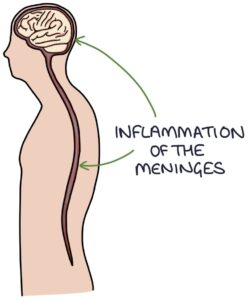Meningitis is inflammation of the meninges, usually due to infection. The meninges are the lining of the brain and spinal cord. Cerebrospinal fluid (CSF) is contained within the meninges (in the subarachnoid space).

Bacterial Meningitis
The causes of bacterial meningitis include:
- Neisseria meningitidis
- Streptococcus pneumoniae (pneumococcus)
- Haemophilus influenzae
- Group B streptococcus (GBS) (particularly in neonates as GBS may colonise the vagina)
- Listeria monocytogenes (particularly in neonates)
Neisseria meningitidis is a gram-negative diplococcus bacteria. They are circular bacteria (cocci) that occur in pairs (diplo-). It is commonly known as meningococcus.
Meningococcal meningitis is when the bacteria infects the meninges and the cerebrospinal fluid. Meningococcal septicaemia is when the meningococcus bacterial infection is in the bloodstream. Meningococcal septicaemia can cause the classic non-blanching rash.
Viral Meningitis
The most common causes of viral meningitis are:
- Enteroviruses (e.g., coxsackievirus)
- Herpes simplex virus (HSV)
- Varicella zoster virus (VZV)
Viral PCR testing can be performed on a CSF sample. Aciclovir is used to treat HSV and VZV.
Presentation
Typical symptoms of meningitis are:
- Fever
- Neck stiffness
- Vomiting
- Headache
- Photophobia
- Altered consciousness
- Seizures
Where there is meningococcal septicaemia, children can present with a non-blanching rash. Other causes of bacterial meningitis do not usually cause the non-blanching rash.
Neonates and babies can present with non-specific signs and symptoms, such as hypotonia, poor feeding, lethargy, hypothermia and a bulging fontanelle. The NICE guidelines on sepsis recommend lumbar puncture as part of the investigations for children with suspected sepsis who are:
- Under 1 month, presenting with fever
- 1 to 3 months and are unwell or have a low or high white blood cell count
There are two special tests you can perform to look for meningeal irritation:
- Kernig’s test
- Brudzinski’s test
Kernig’s test involves lying the patient on their back, flexing one hip and knee to 90 degrees and then slowly straightening the knee whilst keeping the hip flexed at 90 degrees. This creates a slight stretch in the meninges. Where there is meningitis, it will produce spinal pain or resistance to movement.
Brudzinski’s test involves lying the patient flat on their back and gently using your hands to lift their head and neck off the bed, flexing their chin to their chest. A positive test, indicating meningitis, is when this causes the patient to flex their hips and knees involuntarily.
Lumbar Puncture
A lumbar puncture involves inserting a needle into the lower back to collect a sample of cerebrospinal fluid (CSF). The spinal cord ends at the L1-L2 vertebral level. The needle is usually inserted into the L3-L4 or L4/L5 intervertebral space. Samples are sent for bacterial culture, viral PCR, cell count, protein and glucose. A blood glucose sample is sent at the same time for comparison to the CSF sample. The samples are sent immediately.
|
Cerebrospinal Fluid |
Bacterial |
Viral |
|
Appearance |
Cloudy |
Clear |
|
Protein |
High |
Mildly raised or normal |
|
Glucose |
Low |
Normal |
|
White Cell Count |
High (neutrophils) |
High (lymphocytes) |
|
Culture |
Bacteria |
Negative |
TOM TIP: Lumbar puncture interpretation is a common exam question. Think about what will happen with bacteria or viruses living in the CSF rather than rote learning the results. Bacteria swimming in the CSF will release proteins and use up glucose. Viruses may release a small amount of protein and do not use up glucose. The immune system releases more neutrophils with bacteria and lymphocytes with viruses.
Management of Bacterial Meningitis
Bacterial meningitis is a medical emergency and should be treated immediately.
Children seen in the primary care setting with suspected meningitis and a non-blanching rash should receive an urgent dose of benzylpenicillin (IM or IV) while awaiting transfer to hospital (it should not delay transfer). Where there is a true penicillin allergy, transfer should be the priority rather than other antibiotics. Doses of benzylpenicillin are:
- Under 1 year – 300mg
- 1-9 years – 600mg
- Over 10 years – 1200mg
Ideally, blood cultures and a lumbar puncture should be performed before starting antibiotics. However, antibiotics should not be delayed if the patient is acutely unwell.
Blood tests should include a meningococcal PCR if meningococcus is suspected. This tests for meningococcal DNA. It can give a result faster than blood cultures (depending on local services) and will still be positive after the bacteria has been treated with antibiotics.
There should be a low threshold for treating suspected meningitis, particularly in babies and younger children. Always follow the local guidelines. Typical antibiotics are:
- Under 3 months – cefotaxime plus amoxicillin (amoxicillin is to cover listeria)
- Above 3 months – ceftriaxone
Aciclovir is added if viral meningitis is suspected (mainly herpes simplex virus).
Vancomycin should be added if there is a risk of penicillin-resistant pneumococcal infection (e.g., recent foreign travel or prolonged antibiotic exposure).
Steroids (e.g., dexamethasone) are also used in bacterial meningitis to reduce the frequency and severity of hearing loss and neurological complications.
Bacteria meningitis and meningococcal infection are notifiable diseases to the UK Health Security Agency.
Post-Exposure Prophylaxis
Significant exposure to meningococcal infection puts contacts at risk. This risk is highest with close prolonged contact within 7 days before the onset of the illness. The risk to contacts decreases 7 days after the diagnosis.
Post-exposure prophylaxis is guided by the local health protection team when they are notified of the diagnosis. The usual choice is a single dose of ciprofloxacin given as soon as possible after the diagnosis.
Complications
- Hearing loss (a key complication)
- Seizures and epilepsy
- Cognitive impairment and learning disability
- Memory loss
- Focal neurological deficits, such as limb weakness or spasticity
Last updated July 2023
Now, head over to members.zerotofinals.com and test your knowledge of this content. Testing yourself helps identify what you missed and strengthens your understanding and retention.

